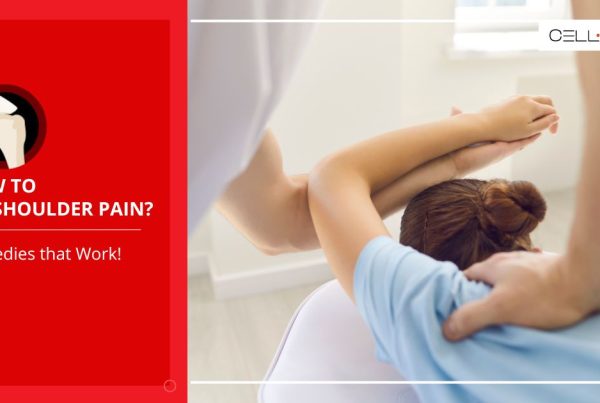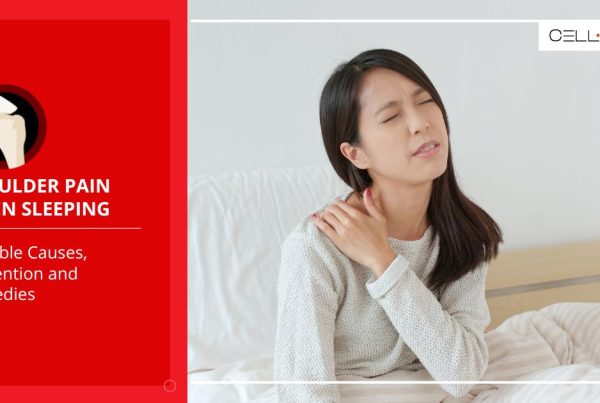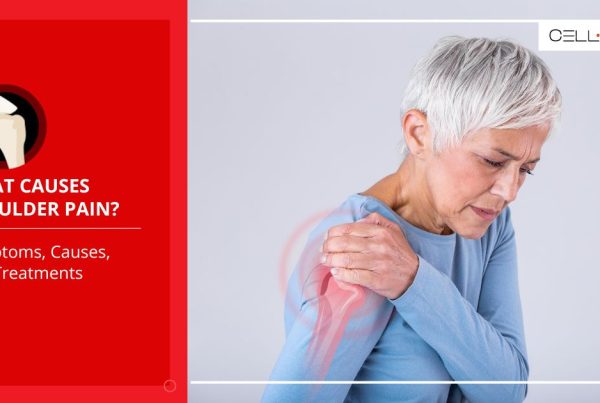Published on: November 5, 2024 | Updated on: January 18, 2025
Shoulder pain when lifting the arm is a common issue experienced by many at various points in their lives. This type of pain can vary, ranging from minor inconvenience to quickly becoming an inhibitor, limiting your daily activities.
Understanding the underlying causes and available treatment is crucial to managing shoulder pain effectively. In fact, addressing shoulder pain when lifting your arm early can prevent further complications and improve your quality of life.
Therefore, it is crucial to understand the anatomy of the shoulder first, as it is the primary step in intercepting shoulder pain.
Understanding the Anatomy of the Shoulder
The shoulder is one of the most complex joints present in the body, comprising bones, muscles, tendons, and ligaments.
Designed to provide a wide range of motion, the rotator cuff allows you to lift, rotate, and move your arm in various directions. The rotator cuff, primarily consisting of four muscles and their tendons, plays the most important part in stabilizing and facilitating the circular motion of the arm and shoulder.
When inflammation or injury affects any of these structures, it typically leads to shoulder pain when lifting the arm. There are several potential causes of shoulder pain when lifting the arm, each with a distinct set of symptoms and with treatment options.
Common Causes of Shoulder Pain When Lifting the Arm
There are several causes of shoulder pain. Here are the most common causes.
1. Rotator Cuff Injury
Among the most common causes of shoulder pain is rotator cuff injury, which is situated in the muscles and tendons surrounding the shoulder.
Rotator cuff injury becomes common with age, especially among people who consistently engage in overhead work, such as painters or carpenters.
Under exceptional circumstances, a rotator cuff tear may be the result of a single blunt injury.
2. Bursitis
The bursa, a fluid-filled sac that cushions the shoulder joint, often causes increased pressure and, hence, pain in the joint. Bursitis occurs from repetitive movements or prolonged pressure on the shoulder.
Usual symptoms include discoloration, redness, and a heated sensation around the shoulder area. It often causes fevers coupled with chills throughout the body.
3. Frozen Shoulder (Adhesive Capsulitis)
Frozen Shoulder (Adhesive Capsulitis) is characterized by extreme stiffness and pain in the shoulder joint. It develops over time, that is, gradually, often after injuries that require you to keep your arm in the same position as having surgery or breaking your arm.
4. Arthritis
The cartilage inside the shoulder often gets damaged due to arthritis, osteoarthritis, and rheumatoid arthritis.
Shoulder arthritis causes pain when lifting the arm due to wear and tear of the cartilage, beginning on the surface and eventually to the layers further down. It typically results in pain, stiffness, and reduced range of motion.
Symptoms and Diagnosis of Shoulder Pain
Various symptoms associated with shoulder pain when lifting the arm include sharp or dull persistent aches implicating underlying causes such as those stated above. The pain may also inhibit the motion and range of the shoulder and arm itself, as it sometimes radiates down the arm.
If persistent, the pain can feel like a constant stinging sensation, which may affect your sleep or worsen if the arm is raised above your head.
Diagnosis of the shoulder typically involves a combination of physical examination and the patient’s history to factor out the causes of the pain, such as a recent fall, accident, or if the patient has a history of disease like arthritis.
Upon examination, the doctor may ask you to perform specific actions to assess the range of motion. This may include moving the shoulder 180 degrees or above your head to diagnose the cause of pain.
Treatment Options for Shoulder Pain
However, treatment for shoulder pain should always be done under the supervision of a doctor or a professional who can correctly guide you toward recovery.
1. Rest and Activity Modifications
One of the best ways to relieve shoulder pain is to rest and avoid strenuous activities that may aggravate the pain.
If you work a job requiring overhead lifting, you should request time off or a change of responsibilities. For better recovery, your doctor might suggest keeping the shoulder in a sling till completely healed.
2. Physical Therapy
Physical therapy is a cornerstone in quick recovery to strengthen the muscles around the shoulder and increase flexibility.
For this purpose, seeking a professional physical therapist who can guide you toward best practices is recommended.
A general physician may recommend a combination of light weights, exercise bands, and weight-bearing exercises such as push-ups or planks.
3. Ice and Heat
If you have had a recent injury and are recovering immediately afterward, it is recommended that you ice the area. It helps numb the pain and reduce inflammation.
For the first 24-48 hours, ice the affected area for 15-20 minutes every three to four hours.
Do not place the ice pack directly onto the skin; instead, wrap it in a cloth or a towel that provides constant cooling without the risk of frostbite.
Preventing Shoulder Pain
To prevent shoulder injury or pain when lifting the arm, it is essential to note that proactive steps to protect the shoulder joint are taken.
- Proper lifting techniques: Use proper techniques when lifting weights or exercising to prevent shoulder joint injury. Techniques such as bending your knees or keeping the weights close to your body reduce strain on your shoulder.
- Ergonomics: Make ergonomics adjustments at work, such as maintaining a straight posture while sitting or standing. If your job consists of heavy lifting activities, make sure to practice safety. If your work consists of a workstation, it is advised to take regular breaks, move your body, and stretch.
Final Words
It is essential to seek medication if you experience severe shoulder pain when lifting the arm, especially if it comes with swelling, discoloration of skin, redness, or sudden loss of motion.
Constant pain that does not wither away with self-care measurement may be a sign to visit a healthcare practitioner, as early intervention can prevent long-term complications, ensuring complete recovery.
Sources
Footnotes
- Lucas J, van Doorn P, Hegedus E, Lewis J, van der Windt D. A systematic review of the global prevalence and incidence of shoulder pain. BMC Musculoskelet Disord. 2022;23:1073.
- Le HV, Lee SJ, Nazarian A, Rodriguez EK. Adhesive capsulitis of the shoulder: review of pathophysiology and current clinical treatments. Shoulder Elbow. 2017 Apr;9(2):75-84.
- Garrett S. Bullock, DPT, PT, Mallory S. Faherty, PhD, LAT, ATC, Leila Ledbetter, MLIS, Charles A. Thigpen, PhD, ATC, PT, and Timothy C. Sell, PhD, PT. Shoulder Range of Motion and Baseball Arm Injuries: A Systematic Review and Meta-Analysis. Journal of Athletic Training 53, no.12: 1190–1199.
References
- Anatomy, Shoulder and Upper Limb, Shoulder Muscles. National Library of Medicine. Accessed 5/09/2024
- Shoulder Pain in Adults. Mayo Clinic. Accessed 5/09/2024
- Rotator Cuff Injury. Mayo Clinic. Accessed 5/09/2024
- Bursitis. Cleveland Clinic. Accessed 5/09/2024
- Frozen Shoulder. Mayo Clinic. Accessed 5/09/2024
- Shoulder Arthritis. Johns Hopkins Medicine. Accessed 5/09/2024
- Shoulder Impingement. NHS UK. Accessed 5/09/2024
- Shoulder pain diagnosis. WebMD. Accessed 5/09/2024
- Best Shoulder Pain Treatment. Harvard Health. Accessed 5/09/2024
- Best Physical Therapy Methods for Shoulders. OrthoBethesda. Accessed 5/09/2024
- Injuries & pain: When to use ice or heat. UnityPoint Health. Accessed 5/09/2024
- How to prevent shoulder injuries. WebMD. Accessed 5/09/2024.
CELLAXYS does not offer Stem Cell Therapy as a cure for any medical condition. No statements or treatments presented by Cellaxys have been evaluated or approved by the Food and Drug Administration (FDA). This site contains no medical advice. All statements and opinions are provided for educational and informational purposes only.
Dr Pejman Bady
Author
Dr. Pejman Bady began his career over 20 years ago in Family/Emergency Medicine, working in fast-paced emergency departments in Nevada and Kansas. He has served the people of Las Vegas as a physician for over two decades. Throughout this time, he has been met with much acclaim and is now the head of Emergency Medical Services in Nye County, Nevada. More about the doctor on this page.
Dr Pouya Mohajer
Contributor
Pouya Mohajer, M.D. is the Director of Spine and Interventional Medicine for CELLAXYS: Age, Regenerative, and Interventional Medicine Centers. He has over 20 years of experience in pain management, perioperative medicine, and anesthesiology. Dr. Mohajer founded and is the Medical Director of Southern Nevada Pain Specialists and PRIMMED Clinics. He has dedicated his career to surgical innovation and scientific advancement. More about the doctor on this page.









